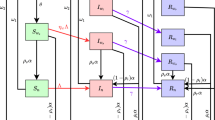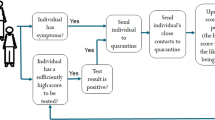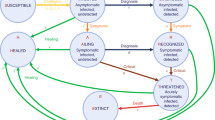Abstract
Testing and isolation of cases is an important component of our strategies to fight SARS-CoV-2. In this work, we consider a compartmental model for Covid-19 including a nonlinear term representing symptom-based testing. We analyze how the considered clinical spectrum of symptoms and the testing rate affect the outcome and the severity of the outbreak.
Access this chapter
Tax calculation will be finalised at checkout
Purchases are for personal use only
Similar content being viewed by others
References
WHO. Novel Coronavirus (2019-nCoV): situation reports. World Health Organization 2020. https://www.who.int/emergencies/diseases/novel-coronavirus-2019/situation-reports
Vetter, P., Vu Diem, L., L’Huillier, A.G., Schibler, M., Kaiser, L., Jacquerioz, F., et al.: Clinical features of COVID-19. BMJ 2020, 369: 1470. https://doi.org/10.1136/bmj.m1470
He, X., et al.: Temporal dynamics in viral shedding and transmissibility of COVID-19. Nat. Med. 26, 672–675 (2020). https://doi.org/10.1038/s41591-020-0869-5
Ashcroft, P., Huisman, J.S., Lehtinen, S., Bouman, J.A., Althaus, C.L., Regoes, R.R., Bonhoeffer, S.: COVID-19 infectivity profile correction. Swiss Med. Wkly, 150:w20336 (2020) https://doi.org/10.4414/smw.2020.20336
He, X., et al.: Author Correction: Temporal dynamics in viral shedding and transmissibility of COVID-19. Nat Med. 26, 1491–1493 (2020). https://doi.org/10.1038/s41591-020-1016-z
R. Mao et al. Manifestations and prognosis of gastrointestinal and liver involvement in patients with COVID-19: a systematic review and meta-analysis. The Lancet 5(7), 667–678 (2020). https://doi.org/10.1016/S2468-1253(20)30126-6
Docherty, A.B., et al.: Features of 16,749 hospitalised UK patients with COVID-19 using the ISARIC WHO Clinical Characterisation Protocol. medR\(\chi \) iv 2020.04.28. https://doi.org/10.1101/2020.04.23.20076042
ECDC. Clinical characteristics of COVID-19. European Centre for Disease Prevention and Control (2020). https://www.ecdc.europa.eu/en/covid-19/latest-evidence/clinical
Guan, W., et al.: Clinical Characteristics of Coronavirus Disease 2019 in China. N. Engl. J. Med. 382, 1708–1720 (2020). https://doi.org/10.1056/NEJMoa2002032
Menni, C., et al.: Real-time tracking of self-reported symptoms to predict potential COVID-19. Nat. Med. 26, 1037–1040 (2020). https://doi.org/10.1038/s41591-020-0916-2
CDC. Real-Time RT-PCR Panel for Detection 2019-nCoV. Centers for Disease Control and Prevention 2020.01.29.
Lia, M.Y., Graef, J.R., Wang, L., Karsai, J.: Global dynamics of a SEIR model with varying total population size. Math. Biosci. 160(2), 191–213 (1990). https://doi.org/10.1016/S0025-5564(99)00030-9
Feng, Z.: Applications of epidemiological models to public health policymaking: the role of heterogeneity in model predictions. World Scientific (2014)
Péni, T., Csutak, B., Szederkényi, G., Röst, G.: Nonlinear model predictive control for COVID-19 management. Nonlinear Dyn. in press
Yang, C., Wang, Y.: A mathematical model for the novel coronavirus epidemic in Wuhan, China. Math. Biosci. Eng. 17(3), 2708–2724 (2020). https://doi.org/10.3934/mbe.2020148
Boldog, P., Tekeli, T., Vizi, Zs., Dénes, A., Bartha, F.A., Röst, G.: Risk Assessment of Novel Coronavirus COVID–19 Outbreaks Outside China. J. Clin. Med. 9(2), 571. https://doi.org/10.3390/jcm9020571
Berger, D.W., Herkenhoff, K.F., Mongey, S.: An SEIR infectious disease model with testing and conditional quarantine. NBER Working Paper No. 26901 (2020). https://doi.org/10.3386/w26901
Weitz, J.S.: COVID-19 Epidemic Risk Assessment for Georgia. Github 2020.03.24. https://github.com/jsweitz/covid-19-ga-summer-2020
Röst, G., et al.: Early phase of the COVID-19 outbreak in Hungary and post-lockdown scenarios. Viruses 12(7), 708 (2020). https://www.mdpi.com/1999-4915/12/7/708
Lofgren, E., Fefferman, N.H., Naumov, Y.N., Gorski, J., Naumova, E.N.: Influenza seasonality: underlying causes and modeling theories. J. Virol. 81(11), 5429–5436 (2007). https://doi.org/10.1128/JVI.01680-06
Olson, K.L., Mandl, K.D.: Seasonal patterns of gastrointestinal illness. Adv. Dis. Surveill. 4, 262. http://faculty.washington.edu/lober/www.isdsjournal.org/htdocs/articles/2188.pdf
Giordano, G., et al.: Modelling the COVID-19 epidemic and implementation of population-wide interventions in Italy. Nat. Med. 26, 855–860 (2020). https://doi.org/10.1038/s41591-020-0883-7
Barbarossa, M.V., et al.: Modeling the spread of COVID-19 in Germany: Early assessment and possible scenarios. PLOS ONE 15(9), e0238559 (2020). https://doi.org/10.1371/journal.pone.0238559
Lauer, S.A., et al.: The incubation period of coronavirus disease 2019 (COVID-19) from publicly reported confirmed cases: estimation and application. Ann. Intern. Med. 172(9), 577–582 (2020). https://doi.org/10.7326/M20-0504
Diekmann, O., Heesterbeek, J.A.P., Roberts, M.G.: The construction of next-generation matrices for compartmental epidemic models. J. R. Soc. Interface 7(47), 873–885 (2020). https://doi.org/10.1098/rsif.2009.0386
Chowell, G., Fenimore, P., Castillo-Garsow, M., Castillo-Chavez, C.: SARS outbreaks in Ontario, Hong Kong and Singapore: the role of diagnosis and isolation as a control mechanism. J. Theor. Biol. 224(1). https://doi.org/10.1098/rsif.2007.1036
Cori, A., Ferguson, N.M., Fraser, C., Cauchemez, S.: A new framework and software to estimate time-varying reproduction numbers during epidemics. Am. J. Epidemiol. 178(9), 1505–1512 (2020). https://doi.org/10.1093/aje/kwt133
Wallinga, J., Lipsitch. M.: How generation intervals shape the relationship between growth rates and reproductive numbers. Proc. R. Soc. B: Biol. Sci. 274(1609), 599–604 (2020). https://royalsocietypublishing.org/doi/full/10.1098/rspb.2006.3754
Acknowledgements
This work was done in the framework of the Hungarian National Development, Research, and Innovation (NKFIH) Fund 2020-2.1.1-ED-2020-00003 and of the grants TUDFO/47138-1/2019-ITM and EFOP-3.6.2-16-2017-00015. Some authors were also supported by NKFIH KKP 129877 (J.K.), NKFIH FK 124016 (T.T.), János Bolyai Research Scholarship of the Hungarian Academy of Sciences (F.B.).
Author information
Authors and Affiliations
Corresponding author
Editor information
Editors and Affiliations
Rights and permissions
Copyright information
© 2021 The Author(s), under exclusive license to Springer Nature Singapore Pte Ltd.
About this chapter
Cite this chapter
Bartha, F.A., Karsai, J., Tekeli, T., Röst, G. (2021). Symptom-Based Testing in a Compartmental Model of Covid-19. In: Agarwal, P., Nieto, J.J., Ruzhansky, M., Torres, D.F.M. (eds) Analysis of Infectious Disease Problems (Covid-19) and Their Global Impact. Infosys Science Foundation Series(). Springer, Singapore. https://doi.org/10.1007/978-981-16-2450-6_16
Download citation
DOI: https://doi.org/10.1007/978-981-16-2450-6_16
Published:
Publisher Name: Springer, Singapore
Print ISBN: 978-981-16-2449-0
Online ISBN: 978-981-16-2450-6
eBook Packages: Mathematics and StatisticsMathematics and Statistics (R0)




